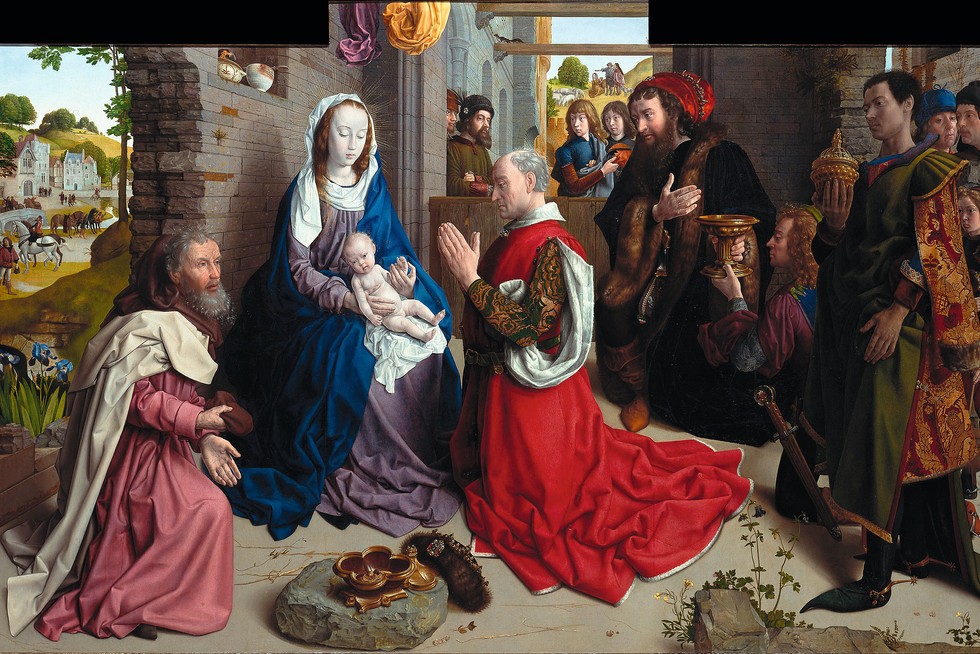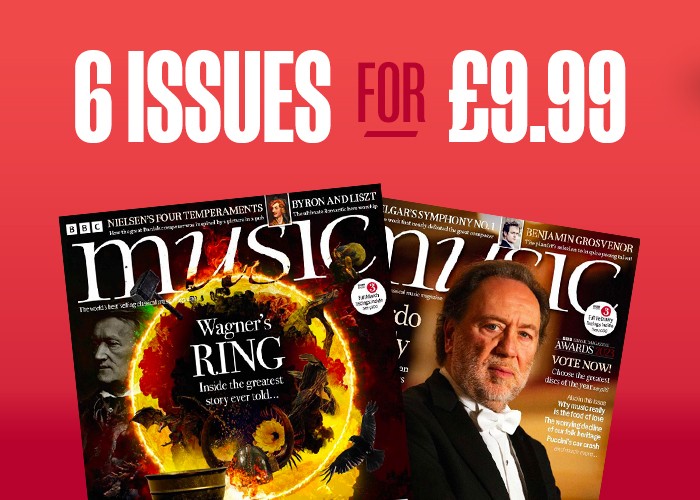La Nativité du Seigneur: a guide to Messiaen's Christmas organ cycle and its best recordings
In his nine-movement depiction of the birth of Christ, La Nativité du Seigneur, Messiaen produced one of the 20th century’s great organ works, says Paul Riley

What must Christmas have been like in the Messiaen household? True, the French composer’s organ cycle La Nativité du Seigneur is populated with piping shepherds, excitable angels and the stately caravanserai of the Wise Men.
La Nativité du Seigneur is also a work full of dense theology and includes a sombre reflection on Christ’s suffering. La Nativité is no be-tinselled festive offering in the spirit of the 18th-century French organ Noëls. It is subtitled ‘Nine meditations’ and, like JS Bach who knew a thing or two about embedding coded messages in his music, Messiaen has a complex cosmology up his sleeve as he unwraps a thoroughgoing interpretation of the mysteries of the Incarnation.
In his Technique of my Musical Language published in 1944, Messiaen declared La Nativité to be the first work to enshrine the essential characteristics of that language – in a sense, his Op. 1. But heads had already been turned by the orchestral Les Offrandes oubliées and by L’Ascension, a work for orchestra which he subsequently repurposed for the organ loft
He had recently been appointed ‘titulaire’ organist to Paris’s Église de la Sainte-Trinité, a singular feather in the 22 year-old’s cap, and he would continue to preside over its famous Cavaillé-Coll instrument until his death some six decades later. Re-worked, L’Ascension stimulated a stream of major organ works, of which La Nativité du Seigneur was the next instalment.
We named La Nativité du Seigneur one of the best pieces of Christmas organ music ever
When did Messiaen compose La Nativité du Seigneur?
La Nativité du Seigneur was composed in the summer of 1935 just outside Grenoble – whose mountains impressed him and left their mark (or so he confessed) on some of the movements steadily taking shape. The premiere took place at La Trinité on 27 February 1936, but instead of giving the first performance himself Messiaen delegated the nine movements to three friends – and furnished an elaborate programme note to aid any listeners baffled by its uncompromising modernity. For further clarity, the published score was provided with an abstruse foreword outlining the work’s religious universe and Messiaen’s compositional principals.
‘The birth of the Lord: this is the subject’, he writes, and then proceeds to explain how it is to be treated. ‘Emotion and sincerity’ are to be the watchword, conveyed by means which are ‘clear and true’. Theologically, he observes that there are nine pieces to honour the motherhood of the Virgin Mary, and among them are considerations of the implications of ‘the Word made flesh’ as well as character pieces describing the angels, shepherds and the Wise Men, all of whom ‘lend a particular poetry to the Christmas Feast’.
Written with the sonorities of La Trinité’s orchestrally conceived organ in mind, he describes how the ‘panels’ of each piece are coloured in new and very particular ways – the pedals often freed from providing the bass line to ‘sing in the soprano’ for the depiction of the Magi’s progress, or to sound a gentle carillon as Mary contemplates her new-born son in ‘La Vierge et l’enfant’ (The Virgin and Child).
For resolute diehards there’s also a set of gnarly, brow-furrowing explanations of the musical processes, including Messiaen’s own customised scale systems – the ‘modes of limited transposition’ – which determine his harmonic thinking. And squirreled away is a note on the additive rhythms that further break down the notions of metrical time – a passion born out of his childhood love for Debussy’s opera Pelléas et Mélisande and his student studies of ancient Greek and Indian rhythms.
As to the meditations themselves, each is prefaced by a Biblical text pinpointing Messiaen’s inspiration. Enfolding a dancing transformation of the plainchant Puer natus est (A boy is born) ‘La Vierge et l’enfant’ expresses maternal wonderment, a wonderment transmitted to the shepherds in the meditation that follows. Their pipes carol under a star-lit canopy whose colours Messiaen likens to stained glass: blue-violet, a touch of red, gold and silver. Next comes ‘Desseins éternels’ (Eternal Designs), an elusive concept clad in elusive colours; and it’s followed by ‘Le Verbe’ (The Word), which is underpinned by Hindu ragas, plainsong and Bach. ‘Les enfants de Dieu’ (The children of God) marks the centre of the work with a joyous fanfare dissolved in tenderness.
Next, the Angels cavort ecstatically ahead of an unexpected intrusion into the Christmas narrative: ‘Jésus accepte la souffrance’ (Jesus accepts his Suffering). Messiaen describes ‘Les Mages’ (The Magi) as a ‘night piece illuminated by grace’; and finally comes the most famous movement of all, ‘Dieu parmi nous’ (God among us), a great hymn of jubilation which culminates in that most ‘French’ of organ default modes, a glorious rip-roaring toccata.
Some have criticised Messiaen for not balancing the movements more adroitly, leaving wide expanses of unrelieved slow music; others have questioned La Nativité’s singular take on the Christmas story. But both reservations miss the point. ‘Illuminating the truth of the Catholic faith,’ Messiaen insisted, ‘is the overriding aspect of my work, the noblest, and no doubt useful and valuable.’ La Nativité shouldn’t be judged as a concert work: it is one believer’s exploration of what gives meaning to his life, a testament to faith and a grateful prayer.
La Nativité du Seigneur best recordings
Olivier Latry (organ)
Deutsche Grammophon 471 4802
To enter fully into Messiaen’s world is to grapple with some potent paradoxes. La Nativité is a score bristling with complex theological concepts, yet tempered by a simple all-yielding faith; a work in one sense timeless, yet encompassing some of the 20th century’s most trenchant ideas about time and harmony; a cycle possessed of a soundworld steeped in the traditions of the French symphonic organ school, yet deliberately setting out to subvert it.
And although Messiaen’s markings specify one arresting colour after another, he was relaxed about the instruments charged with bringing that soundworld to life. Some of the most persuasive performances are on neo-Baroque instruments far removed from the Romantic orchestrally orientated organ at La Trinité, midwife to this very singular Christmas meditation.
More like this
A final conundrum for the performer hoping to crack La Nativité’s abundant challenges: how to balance Messiaen’s prolific instructions with the freedom to pursue that voluptuous sensuality and quasi-improvisational spirit that he believed to be at the heart of the authentic religious experience?
In a catalogue not short of excellent options, two performances stand out above all others, and with their different emphases illuminate the paradoxical tensions that tug at an overall choice. Does the dazzling panache and communicative immediacy of Gillian Weir (see ‘Three other great recordings’, above) win out over Olivier’s Latry’s more spacious, more spiritually focused account? In some respects, undoubtedly. But Latry is steeped in the milieu of Messiaen’s Catholicism. They share a mindset and liturgical background, a sense of reverence less uppermost in Weir’s priorities.
For this 2000 recording, the Deutsche Grammophon sound engineers deployed a dozen-or-so microphones to capture the Notre Dame organ in all its Gallic glory and to tame the fall-out from the cathedral’s generous reverberation. The result is a sonic triumph, allowing Latry’s rapprochement between head and heart to register at every level.
His spaciousness is perhaps a response to the acoustic, but the quicksilver rhythms of ‘Les anges’ are despatched with well-drilled playfulness; ‘Le Verbe’ juxtaposes blazing pedal reeds with incisive passagework on the manuals; and, at a tempo that elucidates very nuance, ‘Dieu parmi nous’ crowns the entire cycle with monumental shock and awe – the reverberation at the close reaching out into eternity.
Gillian Weir (organ)
Priory PRCD921
Deciding between Olivier Latry and Gillian Weir is a well- nigh impossible task; and if, in the end, the sound of the Paris Cavaillé-Coll swings it in Latry’s favour, the magnificent Frobenius organ of Århus Cathedral reminds one that other flavours apply. Weir’s 1994 recording has scrubbed up a treat. The sound is vividly immediate, Weir’s technique is beyond reproach and her identification with the music is sovereign. The shepherds breathe ‘air from other planets’, the angels scintillate and ‘Desseins éternels’ radiates calm submission. Indispensable.
Olivier Messiaen (organ)
Warner Classics 9029542817
Some might suggest that Messiaen’s own 1956 recording deserves to be consigned to the ‘one to avoid’ category – the mono sound shows its age and the tuning can be distinctly bracing. But here is the composer’s vision, transmitted on the instrument for which it was conceived and in the acoustics that shaped it. And it’s far more than just an invaluable historical document or reference point. Messiaen makes even the most static music live, his arabesques float and his epiphanies emerge unmediated.
Jennifer Bate (organ)
Treasure Island Music UKCD600
Messiaen himself described Bate’s performance as ‘truly perfect’ – but then he was habitually generous with his compliments. Recorded 40 years ago at Beauvais Cathedral, it enjoys not only his imprimatur but an authentically ‘French’ sound too. The climax of ‘Les enfants de Dieu’ exudes sonorous majesty diffused in a coda borne heavenwards on billowing clouds of incense. Recorded balance sometimes struggles and the acoustic swallows some of the detail in the fastest passages but, excited and exciting, ‘Dieu parmi nous’ is a visceral tour de force.
And one to avoid…
Rudolf Innig is nothing if not scrupulous in his 1977 recording on the Breil organ of St Martin’s Bad Lippspringe. Some of the phrasing is a little earthbound, though, and the Virgin’s contemplation of her new-born son is more prosaic than hallowed. The major drawback, however, is the instrument itself, which isn’t always characterful enough. The pedal reeds tend to ‘parp’, and the cornet stop palls during its prolonged outing in ‘Le Verbe’.
Main image © Getty Images




